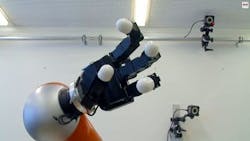Page 2: Researchers develop robotic arm that can catch fast moving objects
In order to model the dynamics of the free flying object, however, the team developed a method in which a density estimate of the translational and rotational velocity of the object is built based on various examples. The team contrasted the performance of six non-linear regression method algorithms, which include:
- Support vector regression (SVR) with radial basis function kernel
- VR with polynomial kernel
- Gaussian mixture regression
- Echo state network
- Genetic programming
- Locally weighted projection regression
The method for real-time motion tracking was tested using five “daily life objects,” which included a ball, a fully-filled bottle, a half-filled bottle, a hammer, and a ping pong racket. When an object is thrown, the cameras help create the model of the object’s kinetics based on trajectory, speed, and rotational movement. Using the aforementioned algorithms and proposed method, Billard and team then translate that model into an equation which then allows the robot to predict the movements of the flying object and position itself quickly in the right direction to catch the object.
The equation that accounts for the translational and rotational velocity of the flying object can be used in closed form and is used as a model for an extended Kalman filter to track and filter noise, explains Billard.
View the EPFL news release.
Also check out:
AUTOMATICA 2014: Innovations in automation and robotics
Live from the AIA Vision show: An outlook on collaborative robots
Snake robots enable automated assembly of aircraft wings
Share your vision-related news by contacting James Carroll, Senior Web Editor, Vision Systems Design
To receive news like this in your inbox, click here.
Join our LinkedIn group | Like us on Facebook | Follow us on Twitter | Check us out on Google +
Page 1 | Page 2
About the Author

James Carroll
Former VSD Editor James Carroll joined the team 2013. Carroll covered machine vision and imaging from numerous angles, including application stories, industry news, market updates, and new products. In addition to writing and editing articles, Carroll managed the Innovators Awards program and webcasts.

